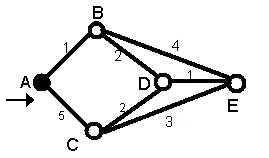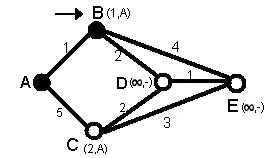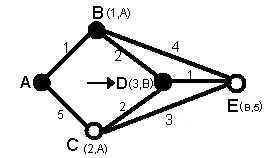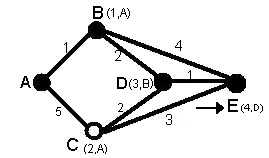Dijkstra's Shortest Path Algorithm
|
Example
of using Dijkstra
algorithm:
Here we want to find the best route between A and E. (See figure 3) You
can see that there are 6 possible routes between A and E (ABE, ACE, ABDE,
ACDE, ABDCE, ACDBE) and its obvious that ABDE is the best route because
its weight is less than other routes. But life is not always so easy and
there are some complicated cases in which we have to use algorithms to
find the best route.
1-As you see in figure 2,the Source node (A) has been chosen as t node and so its label is permanent (we show permanent nodes with filled circles and t nodes with --> mark)

Figure 2
2-In this step you see that status record set of tentative nodes that have a direct link to t node, (B, C), has been changed. Also since B has less weight, it has been chosen as t node and so its label has changed to permanent. (See figure 3)

Figure 3
3-In this step like step 2,the status record set of tentative nodes that have a direct link to t node, (D, E), has been changed. Also since D has less weight, it has been chosen as t node and so its label has changed to permanent (See figure 4)

Figure 4
4-Here we don’t have any tentative node so we should just identify the next t node. Since E has the least weight, it has been chosen as t node.

Figure 5
5-E is the destination, so we shouldn't continue.
We are at end! So we have to identify the route. The previous node of
E is D and previous node of D is B and its previous node is A. So the
best route is ABDE. In this case the total weigh is 4 (1+2+1=4).
Although this algorithm
works well, its so complicated that may take long time for routers to
process it and so the efficiency of network fails. Also if a router gives
wrong information to other routers, all routing decisions will be ineffective.
you can see the source of program written
by C to understand this algorithm better:
| #define MAX_NODES 1024
/* maximum number of nodes */ #define INFINITY 1000000000 /* a number larger than every maximum path */ int n,dist[MAX_NODES][MAX_NODES]; /*dist[I][j] is the distance from i to j */ void shortest_path(int s,int t,int path[ ]) {struct state { /* the path being worked on */ int predecessor ; /*previous node */ int length /*length from source to this node*/ enum {permanent, tentative} label /*label state*/ }state[MAX_NODES]; int I, k, min; struct state * p; for (p=&state[0];p<&state[n];p++){ /*initialize state*/ p->predecessor=-1 p->length=INFINITY p->label=tentative; } state[t].length=0; state[t].label=permanent ; k=t ; /*k is the initial working node */ do{ /* is the better path from k? */ for I=0; I<n; I++) /*this graph has n nodes */ if (dist[k][I] !=0 && state[I].label==tentative){ if (state[k].length+dist[k][I]<state[I].length){ state[I].predecessor=k; state[I].length=state[k].length + dist[k][I] } } /* Find the tentatively labeled node with the smallest label. */ k=0;min=INFINITY; for (I=0;I<n;I++) if(state[I].label==tentative && state[I].length < min)=state[I].length; k=I; } state[k].label=permanent }while (k!=s); /*Copy the path into output array*/ I=0;k=0 Do{path[I++]=k;k=state[k].predecessor;} while (k>=0); } |